Exploring the Spatial Arrangement of Simple 18-Membered Hexaazatetraamine Macrocyclic Ligands in Their Metal Complexes
Abstract
:1. Introduction
2. Results and Discussion
2.1. Synthesis
2.2. X-ray Diffraction Studies
2.2.1. Ligands
| Figures for the Ligand | Ligand, Counterion | CSD_REFCOD | Symmetry, Folding | CPy-CH(2)-NH(2)-CH(2) Conformations Chirality in Each Spacer | Ref. |
|---|---|---|---|---|---|
 | L | This work | Ci Wave | Gauche and alternate (see Figure 1 and Figure S1) | This work |
 | [H4L]4+, 4(Br−) | ZIVPAV | Ci Wave | Gauche and alternate | [22] |
 | [H4L]4+, 4(NO3−) | ZUVKUW | Cs Wave | Alternate and alternate | [21] |
 | [H4LMe2]4+, 4(NO3−) | DIJZOO | Ci Wave | Alternate and alternate trans, anti form N: S and N: R | [4] |
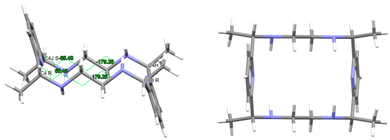 | Lmeso-Me4a | KUBCOA | Cs Wave | Alternate and alternate meso, anti form C: R,R and C: S,S | [12,20] |
 | (H2Lmeso-Me4a)2+, 2(NO3−) | SICCIR | Cs Wave | Alternate and alternate meso, anti form C: R,R and C: S,S | [8] |
 | (H4Lmeso-Me4a)4+, 4(Br−) | NOQFEE | Cs Wave | Alternate and alternate meso, anti form C: R,R and C: S,S | [23] |
 | (H2Lrac-cyp2)2+, 2(Cl−) | EDEWIW | Ci Wave | Gauche and alternate rac form C: R,R and C: S,S | [28] |
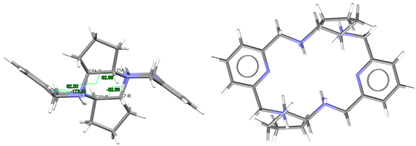 | (H4Lrac-cyp2)4+, 4(Cl−) | EQUGII | Ci Wave | Gauche and alternate rac form: C: R,R and C: S,S | [26] |
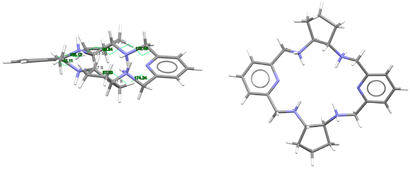 | (H4LSSSS-cyp2)4+, 4(Cl−) | HUVYOP | C2 Ruffle | Alternate and alternate; S,S,S,S form C: S,S and C: S,S | [27] |
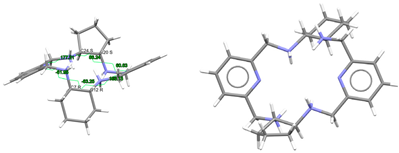 | (H4Lrac-cyph)4+, 4(Cl−) | ZOKNUL | C1 Wave | Gauche and alternate rac form C: R,R and C: S,S | [25] |
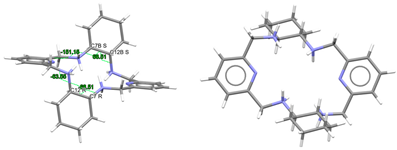 | (H4Lrac-cyh2)4+, 4(Cl−) | VISWOM | Ci Wave | Gauche and alternate rac form C: R,R and C: S,S | [24] |
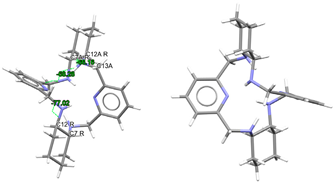 | LRRRRcyh2 | RIVPIX | C2 Ruffle | Gauche λ and λ R,R,R,R form C: R,R and C: R,R | [7] |
2.2.2. Metal Complexes
2.3. Spatial Arrangements of Metal Complexes of Lx Ligands
2.3.1. Complexes of Divalent Metals of d-Block
2.3.2. Complexes of Trivalent Metal Ions
2.4. Photophysical Properties of [DyL(OAc)2]OAc·7H2O·EtOH and [DyLMe2(Cl)2]Cl·2H2O
3. Materials and Methods
3.1. Synthesis
3.2. Crystallographic Refinement and Structure Solution
3.3. Photophysical Properties
4. Conclusions
Supplementary Materials
Author Contributions
Funding
Institutional Review Board Statement
Informed Consent Statement
Data Availability Statement
Conflicts of Interest
References
- Mitewa, M.; Bontchev, P.R. Coordination chemistry of N6 macrocycles. Coord. Chem. Rev. 1994, 135–136, 129–163. [Google Scholar] [CrossRef]
- Rezaeivala, M.; Keypour, H. Schiff base and non-Schiff base macrocyclic ligands and complexes incorporating the pyridine moiety—The first 50 years. Coord. Chem. Rev. 2014, 280, 203–253. [Google Scholar] [CrossRef]
- Corredoira-Vázquez, J.; González-Barreira, C.; Oreiro-Martínez, P.; García-Deibe, A.M.; Sanmartín-Matalobos, J.; Fondo, M. Lanthanoid complexes of pentadentate and hexadentate N5 and N6 macrocycles: Synthesis and applications. J. Rare Earths 2024, 42, 1–15. [Google Scholar] [CrossRef]
- Lamelas, R.; Bastida, R.; Labisbal, E.; Macías, A.; Pereira, T.; Pérez-Lourido, P.; Valencia, L.; Vila, J.M.; Núñez, C. A new series of lanthanide complexes with the trans-disubstituted Py2[18]aneN6 macrocyclic ligand: Synthesis, structures and properties. Polyhedron 2019, 160, 180–188. [Google Scholar] [CrossRef]
- Bligh, S.W.A.; Choi, N.; Evagorou, E.G.; Li, W.-S.; McPartlin, M. Metal-ion controlled helicity of an 18-membered hexaaza tetraamine macrocycle. J. Chem. Soc. Chem. Commun. 1994, 2399–2400. [Google Scholar] [CrossRef]
- Gerus, A.; Ślepokura, K.; Lisowski, J. Carbonate-bridged dinuclear lanthanide(III) complexes of chiral macrocycle. Polyhedron 2019, 170, 115–121. [Google Scholar] [CrossRef]
- Gerus, A.; Ślepokura, K.; Lisowsk, J. Anion and solvent induced chirality inversion in macrocyclic lanthanide complexes. Inorg. Chem. 2013, 52, 12450–12460. [Google Scholar] [CrossRef] [PubMed]
- Fernández-Fernández, M.C.; Bastida, R.; Macías, A.; Perez-Lourido, P.; Valencia, L. Synthesis and Characterization of Lanthanide(III) Nitrate Complexes of an Hexaaza Macrocyclic Ligand. Z. Anorg. Allg. Chem. 2007, 633, 747–751. [Google Scholar] [CrossRef]
- Gregoliński, J.; Ślepokura, K.; Lisowski, J. Lanthanide Complexes of the Chiral Hexaaza Macrocycle and Its meso-Type Isomer: Solvent-Controlled Helicity Inversion. Inorg. Chem. 2007, 46, 7923–7934. [Google Scholar] [CrossRef]
- Newkome, G.R.; Majestic, V.K.; Fronczek, F.R. Octahedral complexes derived from a Hexaaza-18-crown-6 ligand: 3,6,12,15-tetramethyl-18 {[N(2,6)-pyridino,N-1.2.1]2-coronand-6}. Inorg. Chim. Acta 1983, 77, L47–L49. [Google Scholar] [CrossRef]
- Valencia, L.; Pérez-Lourido, P.; Bastida, R.; Macías, A. Mn(II) azamacrocyclic bromide complexes with different nuclearities. J. Organomet. Chem. 2009, 694, 2185–2190. [Google Scholar] [CrossRef]
- Fernández-Fernández, M.C.; Bastida, R.; Macias, A.; Perez-Lourido, P.; Valencia, L. Ni(II) complexes of stereo-isomeric hexazamacrocyclic ligands derived from 2,6-diacetylpyridine. Polyhedron 2009, 28, 2371–2376. [Google Scholar] [CrossRef]
- Bryant, L.H., Jr.; Lachgar, A.; Coates, K.S.; Jackes, S.C. Synthesis, optical resolution, and X-ray crystal structure of a helical hexaazamacrocyclic zinc complex. Inorg. Chem. 1994, 33, 2219–2226. [Google Scholar] [CrossRef]
- Bryant, L.H., Jr.; Lachgar, A.; Jackels, S.C. Untwisting a Helically Coordinated Hexaazamacrocycle: Divalent Mg, Ca, Sr, Cd, Hg, and Pb Complexes of (pyo)2[18]dieneN6 and the X-ray Crystal Structure of the Cd Complex. Inorg. Chem. 1995, 34, 4230–4238. [Google Scholar] [CrossRef]
- Branco, L.; Costa, J.; Delgado, R.; Drew, M.G.B.; Félix, V.; Goodfellow, B.J. Metal complexes of dipyridine hexaaza macrocycles. Structural differences between 18- and 20-membered macrocycles on complexation. J. Chem. Soc. Dalton Trans. 2002, 3539–3550. [Google Scholar] [CrossRef]
- Groom, C.R.; Bruno, I.J.; Lightfoot, M.P.; Ward, S.C. The Cambridge Structural Database. Acta Cryst. 2016, 72, 171–179. [Google Scholar] [CrossRef] [PubMed]
- Corredoira-Vázquez, J.; González-Barreira, C.; García-Deibe, A.M.; Sanmartín-Matalobos, J.; Hernández-Rodríguez, M.A.; Brites, C.D.S.; Carlos, L.D.; Fondo, M. Harnessing ligand design to develop primary and self-calibrated luminescent thermometers with field-induced single ion magnet behaviour in Dy3+ complexes. Inorg. Chem. Front. 2024, 11, 1087–1098. [Google Scholar] [CrossRef]
- Rothermel, G.L.; Miao, L.; Hill, A.L.; Jackels, S.C. Macrocyclic ligands with 18-membered rings containing pyridine or furan groups: Preparation, protonation, and complexation by metal ions. Inorg. Chem. 1992, 31, 4854–4859. [Google Scholar] [CrossRef]
- Lamelas, R.; García, V.; Liñares, A.; Bastida, R.; Labisbal, E.; Fernández-Lodeiro, A.; Lodeiro, C.; Núñez, C.; Valencia, L. Novel trans-disubstituted hexaaza-macrocyclic ligands containing pyridine head units: Synthesis, disubstitution and colorimetric properties. Sens. Actuators B Chem. 2016, 225, 481–491. [Google Scholar] [CrossRef]
- Henling, L.M.; Marsh, R.E. Some more space-group corrections. Acta Crystallogr. Sect. C Struct. Chem. 2014, 70, 834–836. [Google Scholar] [CrossRef]
- Dhont, K.I.; Herman, G.G.; Fabretti, A.C.; Lippens, W.; Goeminne, A.M. Protonation and metal-ion complexation in aqueous solution by pyridine containing hexaaza macrocycles. J. Chem. Soc. Dalton Trans. 1996, 1753–1760. [Google Scholar] [CrossRef]
- Nieslanik, E.; Duesler, N.B.; Miao, L.; Jackels, S.C.; Paine, R.T. Pyo2[18]diene-N6.4HBr.H2O. Acta Crystallogr. Sect. C Cryst. Struct. Commun. 1996, 52, 205–207. [Google Scholar] [CrossRef]
- Bligh, S.W.A.; Choi, N.; Evagorou, E.G.; McPartlin, M. Hexaaza and octaaza macrocycles with 2-hydroxy-3,5-dimethylbenzyl pendant arms. J. Chem. Soc. Perkin Trans. 1 1997, 3151–3156. [Google Scholar] [CrossRef]
- Packowski, T.; Gregolinski, J.; Slepokura, K.; Lisowski, J. 6 + 6 Macrocycles derived from 2,6-diformylpyridine and trans-1,2-diaminocyclohexane. Tetrahedron Lett. 2018, 59, 3669–3673. [Google Scholar] [CrossRef]
- Frydrych, R.; Slepokura, K.; Bil, A.; Gregolinski, J. Mixed Macrocycles derived from 2,6-diformylpyridine and opposite enantiomers of trans-1,2-diaminocyclopentane and trans-1,2-diaminocyclohexane. J. Org. Chem. 2019, 84, 5695–5711. [Google Scholar] [CrossRef]
- Gregolinski, J.; Slepokura, K.; Packowski, T.; Panek, J.; Stefanowicz, P.; Lisowski, V. From 2 + 2 to 8 + 8 condensation products of diamine and dialdehyde: Giant container-shaped macrocycles for multiple anion binding. J. Org. Chem. 2016, 81, 5285–5294. [Google Scholar] [CrossRef]
- Gregolinski, J.; Slepokura, K.; Bil, A.; Lisowski, J. A new synthetic strategy leading to momochiral macrocycles derived from 2,6-diformylpyridine and (1S,2S)-trans-1,2-diaminocyclopentane. Eur. J. Org. Chem. 2020, 2020, 5714–5728. [Google Scholar] [CrossRef]
- Gregolinski, J.; Slepokura, K.; Packowski, T.; Lisowski, J. CCDC 1452087: Experimental crystal structure determination. CSD Commun. 2017. [Google Scholar] [CrossRef]
- Bu, X.-H.; Lu, S.-L.; Zhang, R.-H.; Wang, H.-G.; Yao, X.-K. Crystal structure and properties of neodymium complex with hexaazacyclooctadecane ligand. Polyhedron 1997, 16, 3247–3251. [Google Scholar] [CrossRef]
- Marsh, R.E. Space group Cc: An update. Acta Cryst. Sect. B Struct. Sci. 2004, 60, 252–253. [Google Scholar] [CrossRef]
- Wang, H.-G.; Zhao, J.-J.; Jin, T.-Z.; Xu, G.-X.; Zhou, Z.-Y.; Zhou, X.-G. Synthesis and structure of a dimeric hydroxobridged erbium(III) complex, di-μ-hydroxo-bis[(1,4,7,10,13,16-hexaazacyclooctadecane) erbium(III)] tetra(trifloromethanesulfonate). Polyhedron 1998, 17, 43–47. [Google Scholar] [CrossRef]
- Gajewski, M.; Tuszynski, J.; Mori, H.; Miyoshi, E.; Klobukowski, M. DFT studies of the electronic structure and geometry of 18-crown-6, hexaaza [18]annulene, and their complexes with cations of the heavier alkali and alkaline earth metals. Inorg. Chim. Acta 2008, 361, 2166–2171. [Google Scholar] [CrossRef]
- Shannon, R.D. Revised effective ionic radii and systematic studies of interatomic distances in halides and chalcogenides. Acta Cryst. 1976, A32, 751–767. [Google Scholar] [CrossRef]
- D’Angelo, P.; Zitolo, A.; Migliorati, V.; Chillemi, G.; Duvail, M.; Vitorge, P.; Abadie, S.; Spezia, R. Revised Ionic Radii of Lanthanoid(III) Ions in Aqueous Solution. Inorg. Chem. 2011, 50, 4572–4579. [Google Scholar] [CrossRef]
- Rahm, M.; Hoffmann, R.; Ashcroft, N.W. Atomic and Ionic Radii of Elements 1–96. Chem. A Eur. J. 2016, 22, 14625–14632. [Google Scholar] [CrossRef]
- Kingsbury, C.J.; Senge, M.O. The shape of porphyrins. Coord. Chem. Rev. 2021, 431, 213760. [Google Scholar] [CrossRef]
- Llunell, M.; Casanova, D.; Cirera, J.; Alemany, P.; Alvarez, S. SHAPE: Program for the Stereochemical Analysis of Molecular Fragments by Means of Continuous Shape Measures and Associated Tools; University of Barcelona: Barcelona, Spain, 2010. [Google Scholar]
- Corredoira-Vázquez, J.; Oreiro-Martínez, P.; García-Deibe, A.M.; Sanmartín-Matalobos, J.; Fondo, M. A DyIII complex of a pentadentate Schiff base with field-induced single-ion magnet behaviour. Magnetochemistry 2023, 9, 62. [Google Scholar] [CrossRef]
- Peters, J.A.; Djanashvili, K.; Geraldes, C.F.G.C.; Platas-Iglesias, C. The chemical consequences of the gradual decrease of the ionic radius along the Ln-series. Coord. Chem. Rev. 2020, 406, 2131–2146. [Google Scholar] [CrossRef]
- Rotondo, E.; Aragon-Alberti, M.; Rouquette, J.; Long, J. Modulation of the slow relaxation of the magnetization dynamics through second coordination sphere in macrocyclic dysprosium(III) complexes. Crys. Growth Des. 2024, 24, 1458–1464. [Google Scholar] [CrossRef]
- Maxwell, L.; Amoza, M.; Ruiz, E. Mononuclear lanthanide complexes with 18-crown-6-ether: Synthesis, characterization, magnetic properties, and theoretical studies. Inorg. Chem. 2018, 57, 13225–13234. [Google Scholar] [CrossRef]
- Lisowski, J. Imine- and amine-type macrocycles derived from chiral diamines and aromatic dialdehydes. Molecules 2022, 27, 4097. [Google Scholar] [CrossRef]
- Harriswangler, C.; Caneda-Martínez, L.; Rousseaux, O.; Esteban-Gómez, D.; Fougère, O.; Pujales-Paradela, R.; Valencia, L.; Fernández, M.I.; Lepareur, N.; Platas-Iglesias, C. Versatile macrocyclic platform for the complexation of [natY/90Y] yttrium and lanthanide ions. Inorg. Chem. 2022, 61, 6209–6222. [Google Scholar] [CrossRef]
- Belousov, Y.A.; Korshunov, V.M.; Metlin, M.T.; Metlina, D.A.; Kiskin, M.A.; Aminev, D.F.; Datskevich, N.P.; Drozdov, A.A.; Pettinari, C.; Marchetti, F.; et al. Towards bright dysprosium emitters: Single and combined effects of environmental symmetry, deuteration, and gadolinium dilution. Dye. Pigment. 2022, 199, 110078. [Google Scholar] [CrossRef]
- Mara, D.; Artizzu, F.; Goura, J.; Jayendran, M.; Bokić, B.; Kolaric, B.; Verbiest, T.; Van Deun, R. Molecular dysprosium complexes for white-light and near-infrared emission controlled by the coordination environment. J. Lumin. 2022, 243, 118646. [Google Scholar] [CrossRef]
- Bui, A.T.; Roux, A.; Grichine, A.; Duperray, A.; Andraud, C.; Maury, O. Twisted charge-transfer antennae for ultra-bright terbium(III) and dysprosium(III) bioprobes. Chem. Eur. J. 2018, 24, 3408–3412. [Google Scholar] [CrossRef]
- Kofod, N.; Arppe-Tabbara, R.; Sørensen, T.J. Electronic energy levels of dysprosium(III) ions in solution. Assigning the emitting state and the intraconfigurational 4f–4f transitions in the Vis–NIR region and photophysical characterization of Dy(III) in water, methanol, and dimethyl sulfoxide. J. Phys. Chem. A 2019, 123, 2734–2744. [Google Scholar] [CrossRef]
- Sheldrick, G.M. SADABS, Area-Detector Absorption Correction; Siemens Industrial Automation, Inc.: Madison, WI, USA, 2007. [Google Scholar]
- Sheldrick, G.M. SHELXT—Integrated space-group and crystal-structure determination. Acta Crystallogr. Sect. A Found. Adv. 2015, 71, 3–8. [Google Scholar] [CrossRef]
- Sheldrick, G. Crystal structure refinement with SHELXL. Acta Crystallogr. C Struct. Chem. 2015, 71, 3–8. [Google Scholar] [CrossRef]
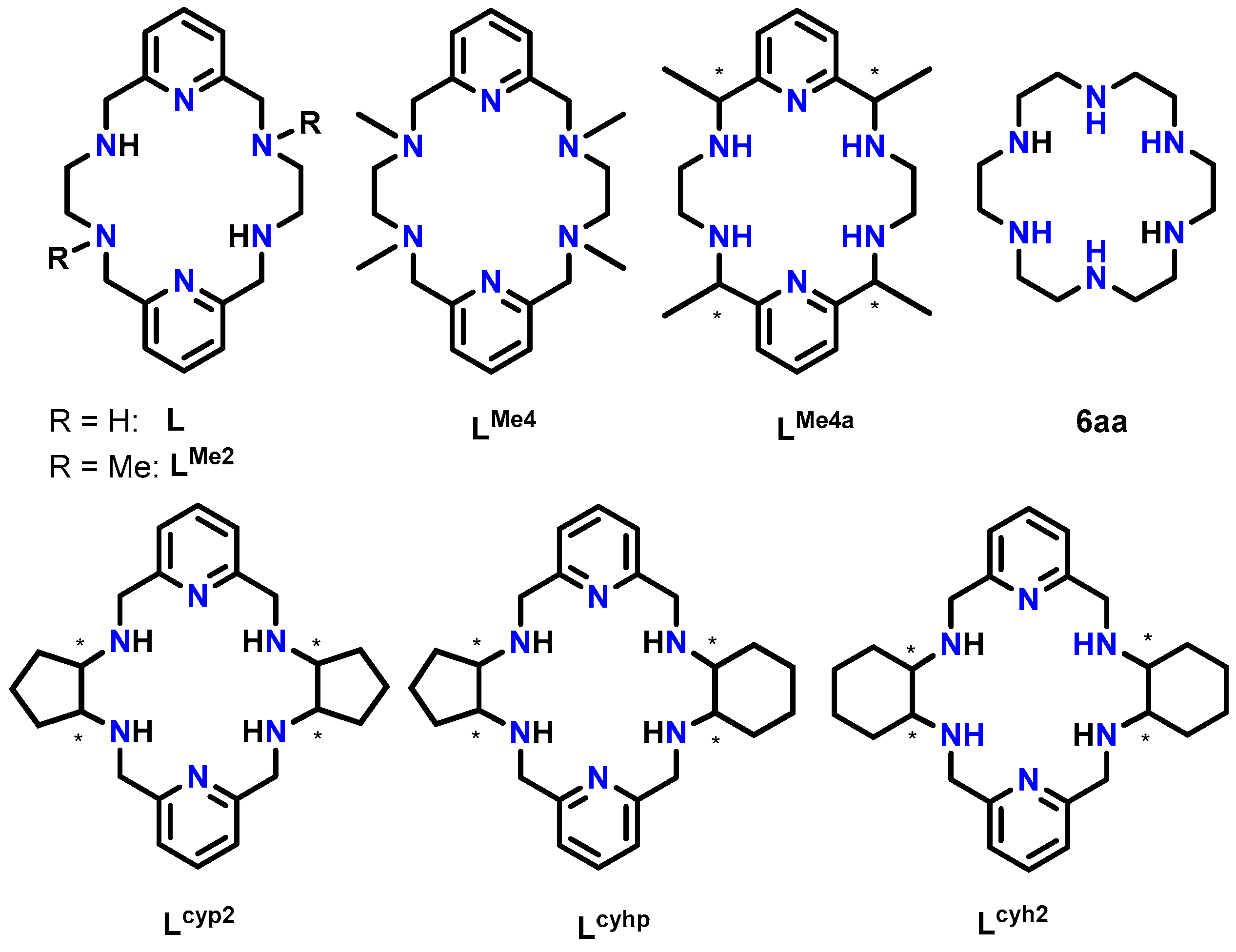
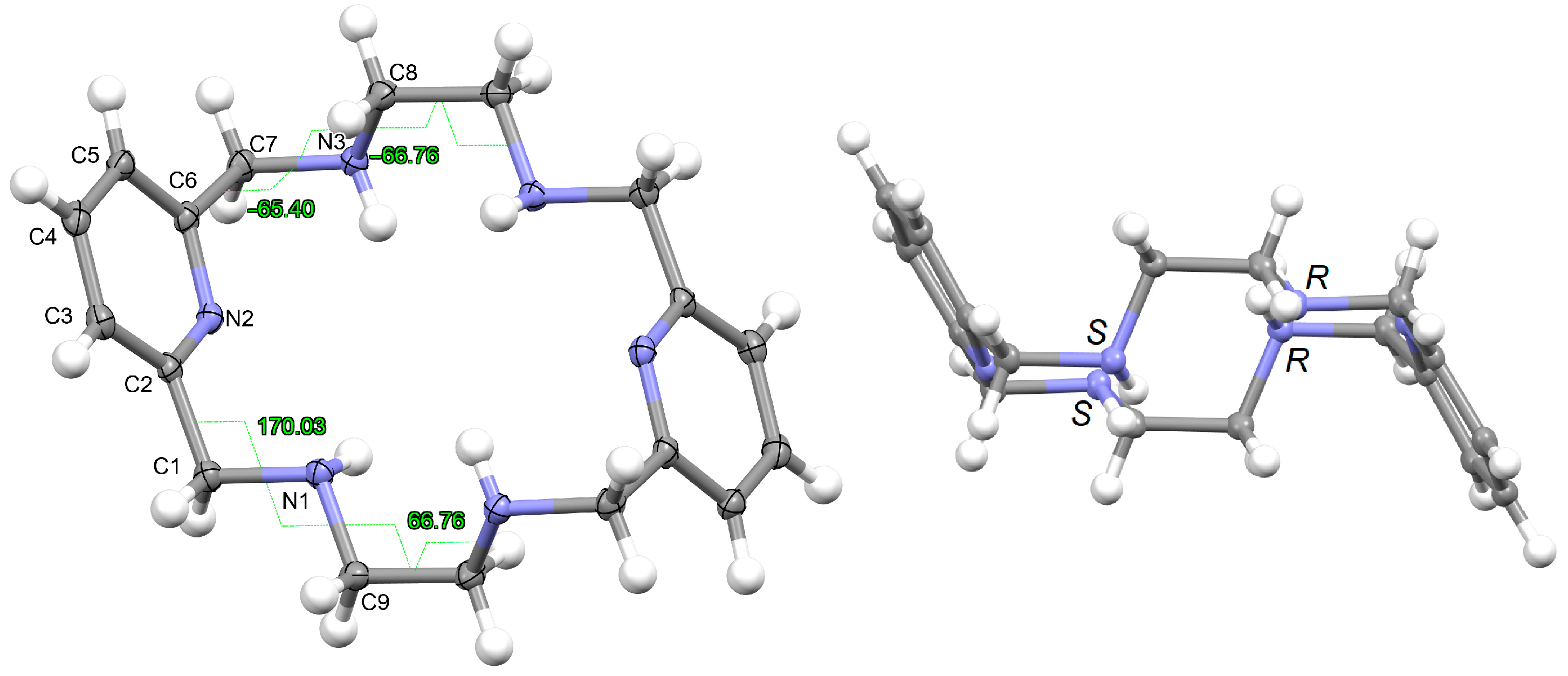
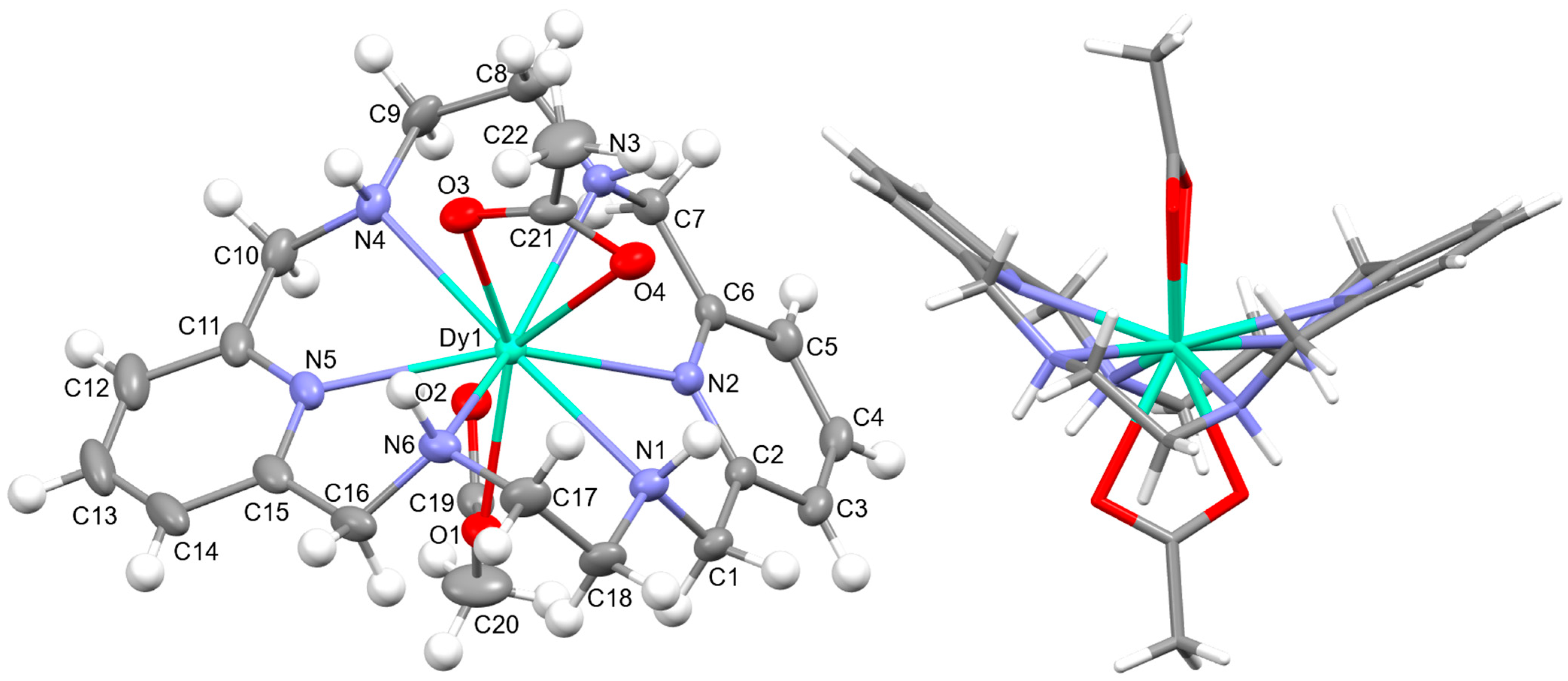
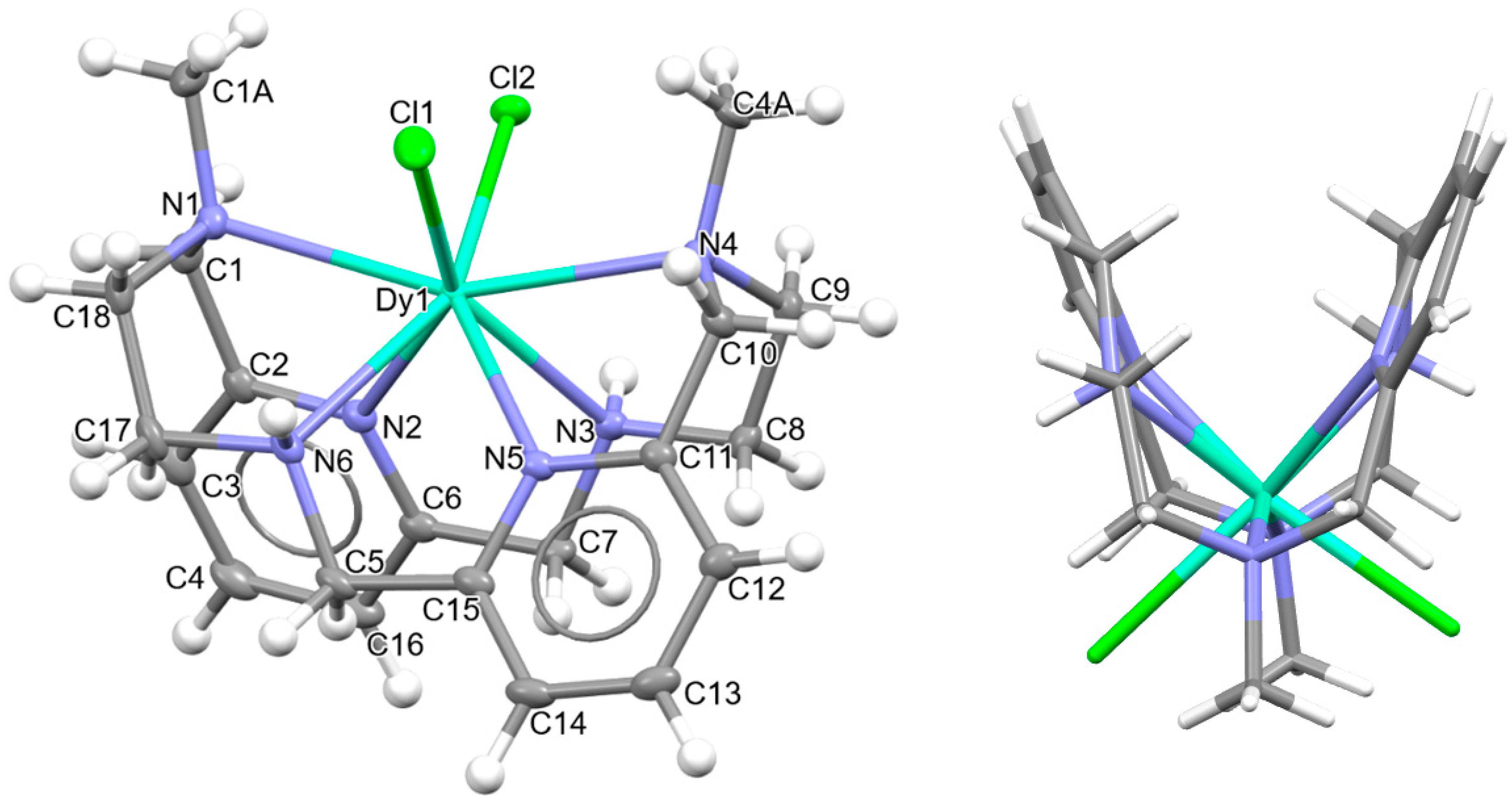

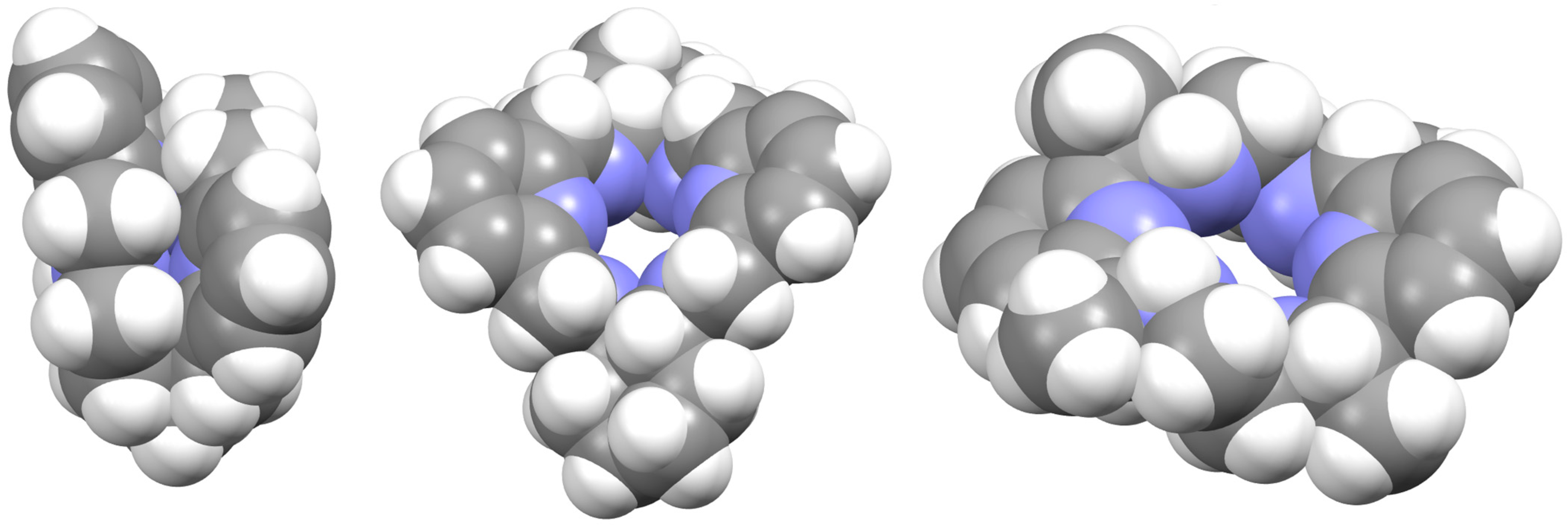

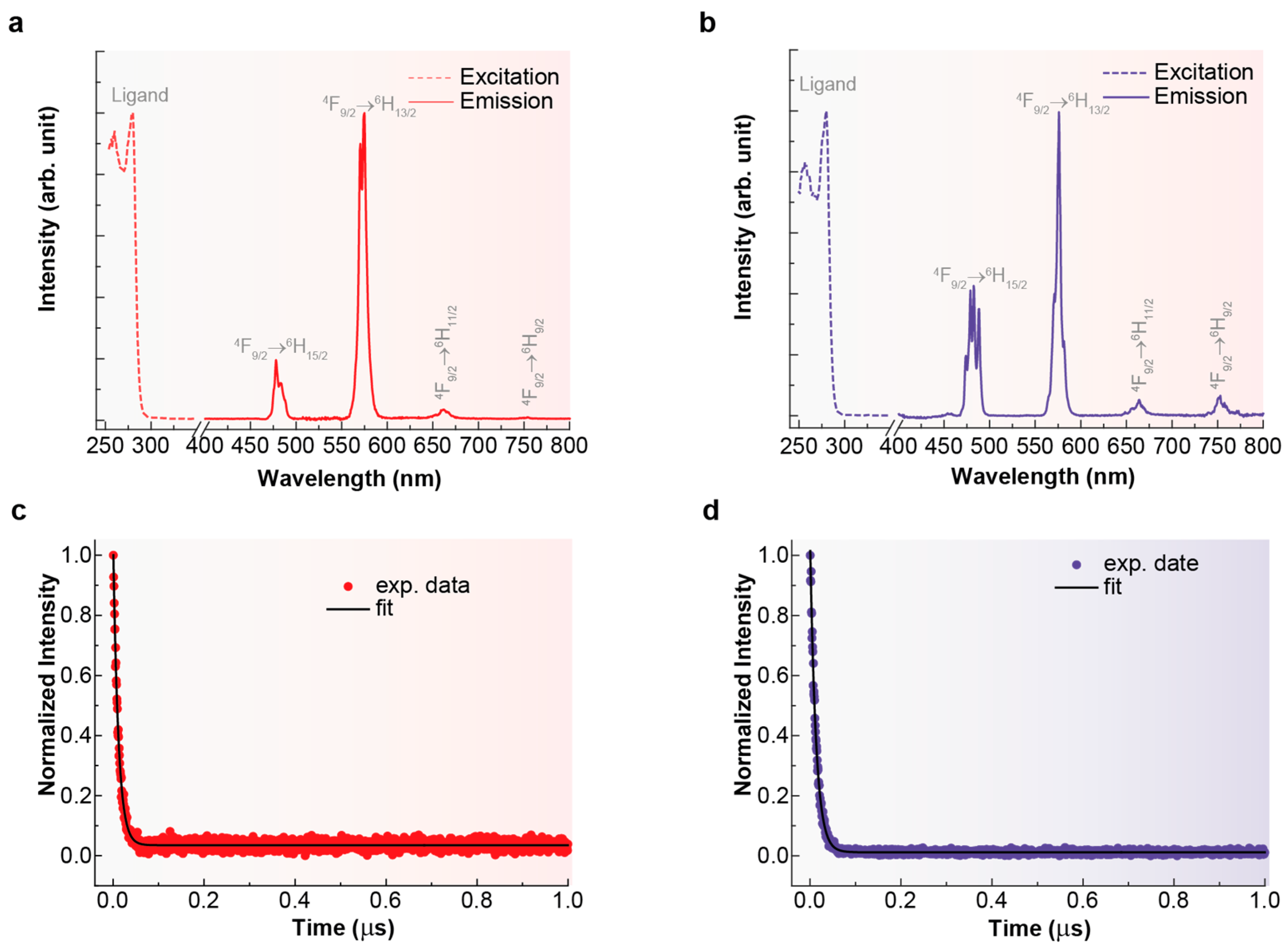
| Compound | τ (μs) | R2 | q (%) |
|---|---|---|---|
| [DyL(OAc)2]OAc·7H2O·EtOH | 11.2 ± 0.1 | 0.98 | 1.70 ± 0.17 |
| [DyLMe2(Cl)2]Cl·2H2O | 12.9 ± 0.6 | 0.99 | 2.10 ± 0.21 |
Disclaimer/Publisher’s Note: The statements, opinions and data contained in all publications are solely those of the individual author(s) and contributor(s) and not of MDPI and/or the editor(s). MDPI and/or the editor(s) disclaim responsibility for any injury to people or property resulting from any ideas, methods, instructions or products referred to in the content. |
© 2024 by the authors. Licensee MDPI, Basel, Switzerland. This article is an open access article distributed under the terms and conditions of the Creative Commons Attribution (CC BY) license (https://creativecommons.org/licenses/by/4.0/).
Share and Cite
Corredoira-Vázquez, J.; González-Barreira, C.; Sanmartín-Matalobos, J.; García-Deibe, A.M.; Fondo, M. Exploring the Spatial Arrangement of Simple 18-Membered Hexaazatetraamine Macrocyclic Ligands in Their Metal Complexes. Int. J. Mol. Sci. 2024, 25, 6802. https://doi.org/10.3390/ijms25126802
Corredoira-Vázquez J, González-Barreira C, Sanmartín-Matalobos J, García-Deibe AM, Fondo M. Exploring the Spatial Arrangement of Simple 18-Membered Hexaazatetraamine Macrocyclic Ligands in Their Metal Complexes. International Journal of Molecular Sciences. 2024; 25(12):6802. https://doi.org/10.3390/ijms25126802
Chicago/Turabian StyleCorredoira-Vázquez, Julio, Cristina González-Barreira, Jesús Sanmartín-Matalobos, Ana M. García-Deibe, and Matilde Fondo. 2024. "Exploring the Spatial Arrangement of Simple 18-Membered Hexaazatetraamine Macrocyclic Ligands in Their Metal Complexes" International Journal of Molecular Sciences 25, no. 12: 6802. https://doi.org/10.3390/ijms25126802












